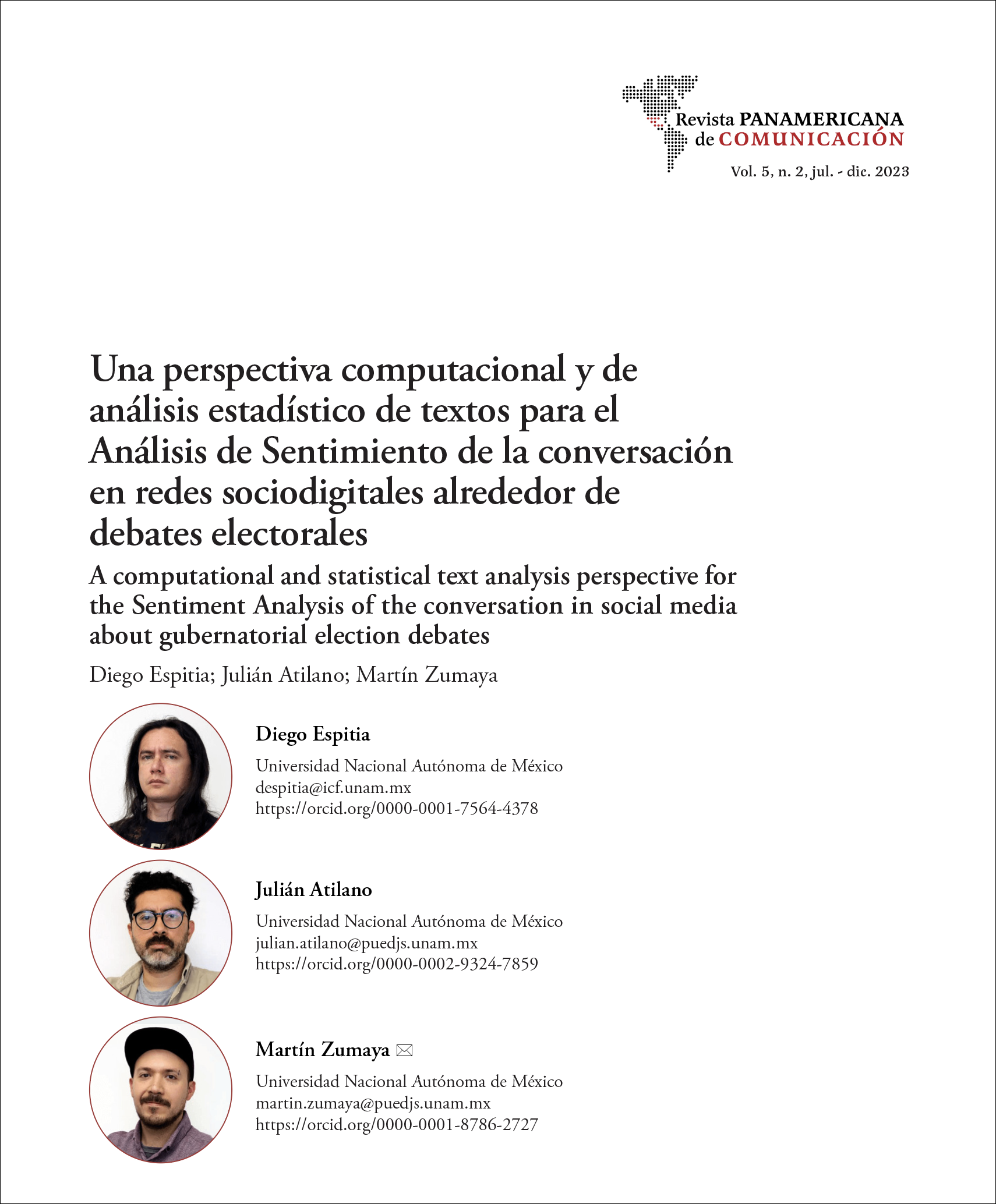Una perspectiva computacional y de análisis estadístico de textos para el Análisis de Sentimiento de la conversación en redes sociodigitales alrededor de debates electorales
Contenido principal del artículo
Resumen
Este trabajo analiza el impacto de las redes sociales en la imagen mediática y la percepción pública de los candidatos en los debates electorales del Estado de México de 2023, utilizando herramientas computacionales y estadísticas para examinar el sentimiento de 40,866 tweets. Se identificaron mayormente menciones negativas hacia Delfina Gómez de la coalición “Juntos hacemos historia”. Sin embargo, a pesar de esto, su campaña fue efectiva en transmitir su imagen mediática, destacándose la palabra “maestra” en las publicaciones sobre ella. Por otro lado, la imagen de Alejandra del Moral de la alianza “Va por el Estado de México” no tuvo el mismo impacto mediático en los tweets analizados. Este estudio muestra la relevancia de las redes sociales en las estrategias de campaña modernas, evidenciando cómo las discusiones digitales influencian la construcción de la imagen de los candidatos. La combinación de análisis cuantitativo y cualitativo permite entender no solo la cantidad de menciones, sino también el contexto y la evolución de la percepción pública. Este enfoque proporciona una metodología alternativa para analizar eventos políticos y sociales en la era digital.
Detalles del artículo
Sección

Esta obra está bajo una licencia internacional Creative Commons Atribución-NoComercial-SinDerivadas 4.0.
Cómo citar
Referencias
Banchs, R. E. (2013). Text Mining with MATLAB. Springer. https://doi.org/10.1007/978-1-4614-4151-9
Belcastro, L., Cantini, R., Marozzo, F., Talia, D., & Trunfio, P. (2020). Learning political polarization on social media using neural networks, IEEE access, 8, 47177-47187. https://doi.org/10.1109/ACCESS.2020.2978950
Brunschke, J., & Divine, L. (2017). Debunking Nixon’s radio victory in the 1960 election: Re-analyzing the historical record and considering currently unexamined polling data. The social science journal, 54(1), 67-75. https://doi.org/10.1016/j.soscij.2016.09.007
Bruns, A., & Burgess, J. (2011). #Ausvotes: how Twitter covered the 2010 Australian federal election. Communication, politics and culture, 44(2), 37-56.
Cambria, E., & White, B. (2014). Jumping NLP Curves: A Review of Natural Language Processing Research. IEEE Computational intelligence magazine, 9(2), 48-57. https://doi.org/10.1109/mci.2014.2307227
Caloca Lafont, E., & Ruiz Molina, F. (Coords.) (2023). Primer Informe: La Valiente y La Maestra. Discurso e imagen pública de las candidatas a gobernadora del Estado de México. Observatorio Electoral de Medios y Redes Socio-digitales 2023, PUEDJS, UNAM, México, 31 pp.
Chaudhry, H. N., Javed, Y., Kulsoom, F., Mehmood, Z., Khan, Z. I., Shoaib, U., & Janjua, S. H. (2021). Sentiment analysis of before and after elections: Twitter data of U.S. Election 2020. Electronics, 10(17), 2082. https://doi.org/10.3390/electronics10172082
Duncombe, C. (2019). The politics of Twitter: Emotions and the power of social media. International political sociology, 13(4), 409–429. https://doi.org/10.1093/ips/olz013
Hardesty, L. (2017). Explained: Neural networks ballyhooed artificial-intelligence technique known as “deep learning” revives 70-year-old idea. MIT News Office. https://news.mit.edu/2017/explained-neural-networks-deep-learning-0414
Highfield, T., Harrington, S., & Bruns, A. (2013). Twitter as a technology for audiencieng and fandom. The #Eurovision phenomenon. Information, communication & society, 16(3), 315-339. https://doi.org/10.1080/1369118X.2012.756053
Himelboim, I., Sweetser, K. D., Tinkham, S. F., Cameron, K., Danelo, M., & West, K. (2014). Valence-based homophily on Twitter: Network analysis of emotions and political talk in the 2012 presidential election. New media & society, 18(7), 1382-1400. https://doi.org/10.1177/1461444814555096
Jänicke, S., Franzini, G., Cheema, M. F., & Scheuermann, G. (2015). On close and distant reading in digital humanities: A survey and future challenges. Eurographics conference on visualization (EuroVis).
Kalsnes, B., Krumsvik, A. H., & Storsul, T. (2014). Social media as a political backchannel. Journal of information management, 66 (3), 313–328. https://doi.org/10.1108/ajim-09-2013-0093
McKinney, M., & Warner, B. (2013). Do presidential debates matter? Examining a decade of campaign debate effects. Argumentation and advocacy, 49, 238-258. https://doi.org/10.1080/00028533.2013.11821800
Pietrusza, D. (2008). *1960 – LBJ vs. JFK vs. Nixon – The epic campaign that forged three presidencies. Union Square Press.
Steer, K. C. B., Wirth, A., & Halgamuge, S. K. (2009). The rationale behind seeking inspiration from Nature. In R. Chiong (Ed.). Adaptive and natural computing algorithms, 51-76. https://doi.org/10.1007/978-3-642-00267-0_2
The Commission on Presidential Debates (2020). CPD: 1960 Debates. https://www.debates.org/debate-history/1960-debates
Van Ryothoven, E. (2015). Learning to feel, learning to fear? Emotions, imaginaries, and limits in the politics of securitization. Security dialogue, 46(5), 458–75. https://doi.org/10.1177/0967010615574766
Villena-Román, J., & García Morera, J. (2013). TASS - Workshop on Sentiment Analysis at SEPLN. Daedalus, S.A.
Walczak, S., & Cerpa, N. (2003). Artificial neural networks. Encyclopedia of physical science and technology (Third Edition), 631-645. https://doi.org/10.1016/B0-12-227410-5/00837-1.
Yavari, A., Hassanpour, H., Rahimpour Cami, B., & Mahdavi, M. (2022). Election prediction based on Sentiment Analysis using Twitter data. International Journal of engineering, 35(2), 372-379. https://doi.org/10.5829/ije.2022.35.02b.13
Valdez, A. (2006). Hipótesis no comprobadas de la mercadotecnia política. Espiral, 13(37), 51-75.

